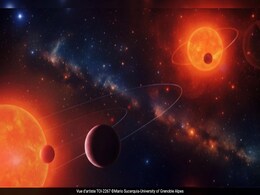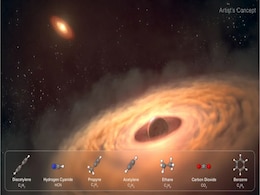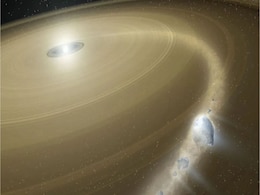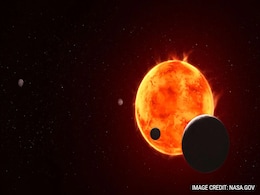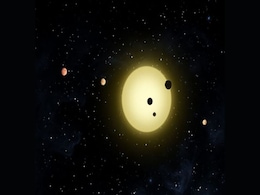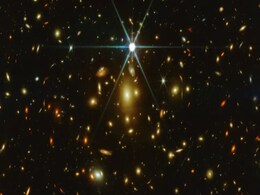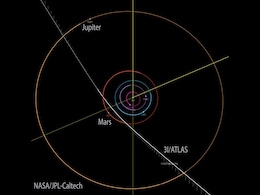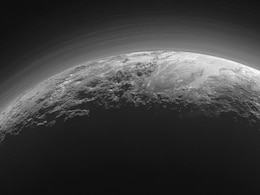Distant Star
- All
- News
- Videos
-

Scientists Inch Closer To Solving Cosmic Dust Mystery On Distant Star
- Wednesday December 3, 2025
- Science | Edited by Srishti Singh Sisodia
The discovery of Kappa Tucanae A's companion star provides a unique "laboratory" for studying hot exozodiacal dust.
-
 www.ndtv.com
www.ndtv.com
-

Webb’s Stunning View of Apep Shows a Rare Triple-Star System Wrapped in Spirals
- Sunday November 23, 2025
- Written by Gadgets 360 Staff
Webb’s mid-infrared images of Apep reveal a rare triple-star system producing vast carbon-rich dust spirals from colliding stellar winds. The two Wolf–Rayet stars and a distant supergiant create layered shells that record centuries of activity and enrich the galaxy with elements vital for future stars and planets.
-
 www.gadgets360.com
www.gadgets360.com
-

James Webb Space Telescope May Have Spotted the Universe’s First Stars, Astronomers Say
- Wednesday November 19, 2025
- Written by Gadgets 360 Staff
Astronomers using the James Webb Space Telescope have detected a distant, metal-poor galaxy whose unusually massive, ultraviolet-bright stars match the expected signatures of Population III — the universe’s first stars. Through the help of gravitational lensing and Webb’s infrared sensitivity, researchers observed light from just 800 million ...
-
 www.gadgets360.com
www.gadgets360.com
-

James Webb Telescope May Have Spotted First Generation of Stars in the Universe
- Sunday November 16, 2025
- Written by Gadgets 360 Staff
Astronomers using JWST may have discovered Population III stars in cluster LAP1-B, offering new insights into early galaxy formation and the universe’s first luminous objects. JWST observations suggest Population III stars may have formed 13 billion years ago, helping trace early galaxies. These stars might be building blocks for larger galaxies ...
-
 www.gadgets360.com
www.gadgets360.com
-

Astronomers Spot First Coronal Mass Ejection from a Distant Star, Raising Questions About Planetary Habitability
- Monday November 17, 2025
- Written by Gadgets 360 Staff
Astronomers detected the first coronal mass ejection from a distant star, revealing that powerful stellar eruptions may strip atmospheres from nearby planets, affecting exoplanet habitability and the search for life.
-
 www.gadgets360.com
www.gadgets360.com
-

Astronomers Report The Biggest Black Hole Flare Ever Seen, With Light Of 10 Trillion Suns
- Tuesday November 4, 2025
- Science | Edited by Ritu Singh
The observed black hole flare is believed to be the largest and most distant one ever recorded, coming from 10 billion light-years away.
-
 www.ndtv.com
www.ndtv.com
-

Hubble Observes Massive Stellar Eruption from EK Draconis, Hinting at Life’s Origins
- Sunday November 2, 2025
- Written by Gadgets 360 Staff
Astronomers using the Hubble Space Telescope observed a huge solar storm from EK Draconis, a young Sun-like star. The eruption’s energy may trigger atmospheric chemistry, forming greenhouse gases and organic molecules. Such events could mirror early solar activity that helped spark life on ancient Earth and distant exoplanets.
-
 www.gadgets360.com
www.gadgets360.com
-

Astronomers Stunned By Three Earth-Sized Planets In Distant Unique Planetary System
- Wednesday October 29, 2025
- Science | Edited by Srishti Singh Sisodia
The study revealed that TOI-2267 has two closely bound stars orbiting each other, and the third planet transits the companion star.
-
 www.ndtv.com
www.ndtv.com
-

James Webb Offers First Glimpse Into How Moons Are Built Around Distant Planets
- Wednesday October 1, 2025
- Written by Gadgets 360 Staff
The James Webb Space Telescope has detected carbon-bearing molecules in a moon-forming disk surrounding CT Cha b, a massive planet-like object orbiting a young star 625 light-years away. The discovery marks the first measurement of its kind and offers clues to how moons like those around Jupiter and Saturn might have formed.
-
 www.gadgets360.com
www.gadgets360.com
-

Hubble Spots White Dwarf Devouring Icy Pluto-Like Planet 260 Light-Years Away
- Wednesday September 24, 2025
- Written by Gadgets 360 Staff
Using Hubble’s ultraviolet spectrograph, scientists detected carbon, nitrogen, sulphur, and abundant oxygen falling onto a white dwarf 260 light-years away, evidence of an icy planetesimal being torn apart. The find shows volatile worlds can persist into a star’s final stages, offering a preview of the Sun’s distant fate.
-
 www.gadgets360.com
www.gadgets360.com
-

Not Like Venus Or Mars, Distant Exoplanet May Have Atmosphere Like Earth's
- Friday September 19, 2025
- World News | Edited by NDTV News Desk
A distant exoplanet might have an atmosphere similar to Earth's, early observations from the James Webb Space Telescope (JWST) suggest. It is part of a group of planets orbiting a star called TRAPPIST-1, about 40 light-years away from Earth.
-
 www.ndtv.com
www.ndtv.com
-

Exoplanets Explained: How Astronomers Find Worlds Orbiting Stars Beyond the Sun
- Monday September 8, 2025
- Written by Gadgets 360 Staff
Exoplanets are planets orbiting stars outside our solar system, hidden by stellar glare and detected indirectly. Astronomers identify them by tracking star wobbles or dips in brightness during planetary transits. NASA’s Kepler mission revealed thousands, with TESS now expanding the search. These discoveries confirm that planetary systems are abun...
-
 www.gadgets360.com
www.gadgets360.com
-

Earendel: JWST Suggests the Most Distant Star May Be a Star Cluster
- Thursday August 21, 2025
- Written by Gadgets 360 Staff
Earendel, the farthest object ever seen, was first thought to be a single massive star from the early universe. New findings from JWST suggest it may instead be a star cluster, with many stars grouped together. Scientists used gravitational lensing to spot Earendel, which made its light appear thousands of times brighter.
-
 www.gadgets360.com
www.gadgets360.com
-

New Interstellar Object 3I/ATLAS Could Reveal Secrets of Distant Worlds
- Saturday July 12, 2025
- Written by Gadgets 360 Staff
Astronomers have confirmed the arrival of 3I/ATLAS, only the third interstellar object ever spotted in our solar system. First seen on July 1, 2025, by the ATLAS survey team in Chile, it was quickly identified by its unusual hyperbolic orbit and comet-like tail. Larger and brighter than either 1I/ʻOumuamua or 2I/Borisov, 3I/ATLAS is estimated to b...
-
 www.gadgets360.com
www.gadgets360.com
-

NASA's New Horizons Proves Deep-Space Navigation via Stellar Parallax
- Sunday July 6, 2025
- Written by Gadgets 360 Staff
NASA’s New Horizons spacecraft accomplished a world-first by performing a deep-space stellar navigation test using stellar parallax. On April 23, 2020, while 438 million miles from Earth, it imaged nearby stars Proxima Centauri and Wolf 359. From the spacecraft’s distant viewpoint, the stars appeared slightly shifted compared to Earth-based obs...
-
 www.gadgets360.com
www.gadgets360.com
-

Scientists Inch Closer To Solving Cosmic Dust Mystery On Distant Star
- Wednesday December 3, 2025
- Science | Edited by Srishti Singh Sisodia
The discovery of Kappa Tucanae A's companion star provides a unique "laboratory" for studying hot exozodiacal dust.
-
 www.ndtv.com
www.ndtv.com
-

Webb’s Stunning View of Apep Shows a Rare Triple-Star System Wrapped in Spirals
- Sunday November 23, 2025
- Written by Gadgets 360 Staff
Webb’s mid-infrared images of Apep reveal a rare triple-star system producing vast carbon-rich dust spirals from colliding stellar winds. The two Wolf–Rayet stars and a distant supergiant create layered shells that record centuries of activity and enrich the galaxy with elements vital for future stars and planets.
-
 www.gadgets360.com
www.gadgets360.com
-

James Webb Space Telescope May Have Spotted the Universe’s First Stars, Astronomers Say
- Wednesday November 19, 2025
- Written by Gadgets 360 Staff
Astronomers using the James Webb Space Telescope have detected a distant, metal-poor galaxy whose unusually massive, ultraviolet-bright stars match the expected signatures of Population III — the universe’s first stars. Through the help of gravitational lensing and Webb’s infrared sensitivity, researchers observed light from just 800 million ...
-
 www.gadgets360.com
www.gadgets360.com
-

James Webb Telescope May Have Spotted First Generation of Stars in the Universe
- Sunday November 16, 2025
- Written by Gadgets 360 Staff
Astronomers using JWST may have discovered Population III stars in cluster LAP1-B, offering new insights into early galaxy formation and the universe’s first luminous objects. JWST observations suggest Population III stars may have formed 13 billion years ago, helping trace early galaxies. These stars might be building blocks for larger galaxies ...
-
 www.gadgets360.com
www.gadgets360.com
-

Astronomers Spot First Coronal Mass Ejection from a Distant Star, Raising Questions About Planetary Habitability
- Monday November 17, 2025
- Written by Gadgets 360 Staff
Astronomers detected the first coronal mass ejection from a distant star, revealing that powerful stellar eruptions may strip atmospheres from nearby planets, affecting exoplanet habitability and the search for life.
-
 www.gadgets360.com
www.gadgets360.com
-

Astronomers Report The Biggest Black Hole Flare Ever Seen, With Light Of 10 Trillion Suns
- Tuesday November 4, 2025
- Science | Edited by Ritu Singh
The observed black hole flare is believed to be the largest and most distant one ever recorded, coming from 10 billion light-years away.
-
 www.ndtv.com
www.ndtv.com
-

Hubble Observes Massive Stellar Eruption from EK Draconis, Hinting at Life’s Origins
- Sunday November 2, 2025
- Written by Gadgets 360 Staff
Astronomers using the Hubble Space Telescope observed a huge solar storm from EK Draconis, a young Sun-like star. The eruption’s energy may trigger atmospheric chemistry, forming greenhouse gases and organic molecules. Such events could mirror early solar activity that helped spark life on ancient Earth and distant exoplanets.
-
 www.gadgets360.com
www.gadgets360.com
-

Astronomers Stunned By Three Earth-Sized Planets In Distant Unique Planetary System
- Wednesday October 29, 2025
- Science | Edited by Srishti Singh Sisodia
The study revealed that TOI-2267 has two closely bound stars orbiting each other, and the third planet transits the companion star.
-
 www.ndtv.com
www.ndtv.com
-

James Webb Offers First Glimpse Into How Moons Are Built Around Distant Planets
- Wednesday October 1, 2025
- Written by Gadgets 360 Staff
The James Webb Space Telescope has detected carbon-bearing molecules in a moon-forming disk surrounding CT Cha b, a massive planet-like object orbiting a young star 625 light-years away. The discovery marks the first measurement of its kind and offers clues to how moons like those around Jupiter and Saturn might have formed.
-
 www.gadgets360.com
www.gadgets360.com
-

Hubble Spots White Dwarf Devouring Icy Pluto-Like Planet 260 Light-Years Away
- Wednesday September 24, 2025
- Written by Gadgets 360 Staff
Using Hubble’s ultraviolet spectrograph, scientists detected carbon, nitrogen, sulphur, and abundant oxygen falling onto a white dwarf 260 light-years away, evidence of an icy planetesimal being torn apart. The find shows volatile worlds can persist into a star’s final stages, offering a preview of the Sun’s distant fate.
-
 www.gadgets360.com
www.gadgets360.com
-

Not Like Venus Or Mars, Distant Exoplanet May Have Atmosphere Like Earth's
- Friday September 19, 2025
- World News | Edited by NDTV News Desk
A distant exoplanet might have an atmosphere similar to Earth's, early observations from the James Webb Space Telescope (JWST) suggest. It is part of a group of planets orbiting a star called TRAPPIST-1, about 40 light-years away from Earth.
-
 www.ndtv.com
www.ndtv.com
-

Exoplanets Explained: How Astronomers Find Worlds Orbiting Stars Beyond the Sun
- Monday September 8, 2025
- Written by Gadgets 360 Staff
Exoplanets are planets orbiting stars outside our solar system, hidden by stellar glare and detected indirectly. Astronomers identify them by tracking star wobbles or dips in brightness during planetary transits. NASA’s Kepler mission revealed thousands, with TESS now expanding the search. These discoveries confirm that planetary systems are abun...
-
 www.gadgets360.com
www.gadgets360.com
-

Earendel: JWST Suggests the Most Distant Star May Be a Star Cluster
- Thursday August 21, 2025
- Written by Gadgets 360 Staff
Earendel, the farthest object ever seen, was first thought to be a single massive star from the early universe. New findings from JWST suggest it may instead be a star cluster, with many stars grouped together. Scientists used gravitational lensing to spot Earendel, which made its light appear thousands of times brighter.
-
 www.gadgets360.com
www.gadgets360.com
-

New Interstellar Object 3I/ATLAS Could Reveal Secrets of Distant Worlds
- Saturday July 12, 2025
- Written by Gadgets 360 Staff
Astronomers have confirmed the arrival of 3I/ATLAS, only the third interstellar object ever spotted in our solar system. First seen on July 1, 2025, by the ATLAS survey team in Chile, it was quickly identified by its unusual hyperbolic orbit and comet-like tail. Larger and brighter than either 1I/ʻOumuamua or 2I/Borisov, 3I/ATLAS is estimated to b...
-
 www.gadgets360.com
www.gadgets360.com
-

NASA's New Horizons Proves Deep-Space Navigation via Stellar Parallax
- Sunday July 6, 2025
- Written by Gadgets 360 Staff
NASA’s New Horizons spacecraft accomplished a world-first by performing a deep-space stellar navigation test using stellar parallax. On April 23, 2020, while 438 million miles from Earth, it imaged nearby stars Proxima Centauri and Wolf 359. From the spacecraft’s distant viewpoint, the stars appeared slightly shifted compared to Earth-based obs...
-
 www.gadgets360.com
www.gadgets360.com








